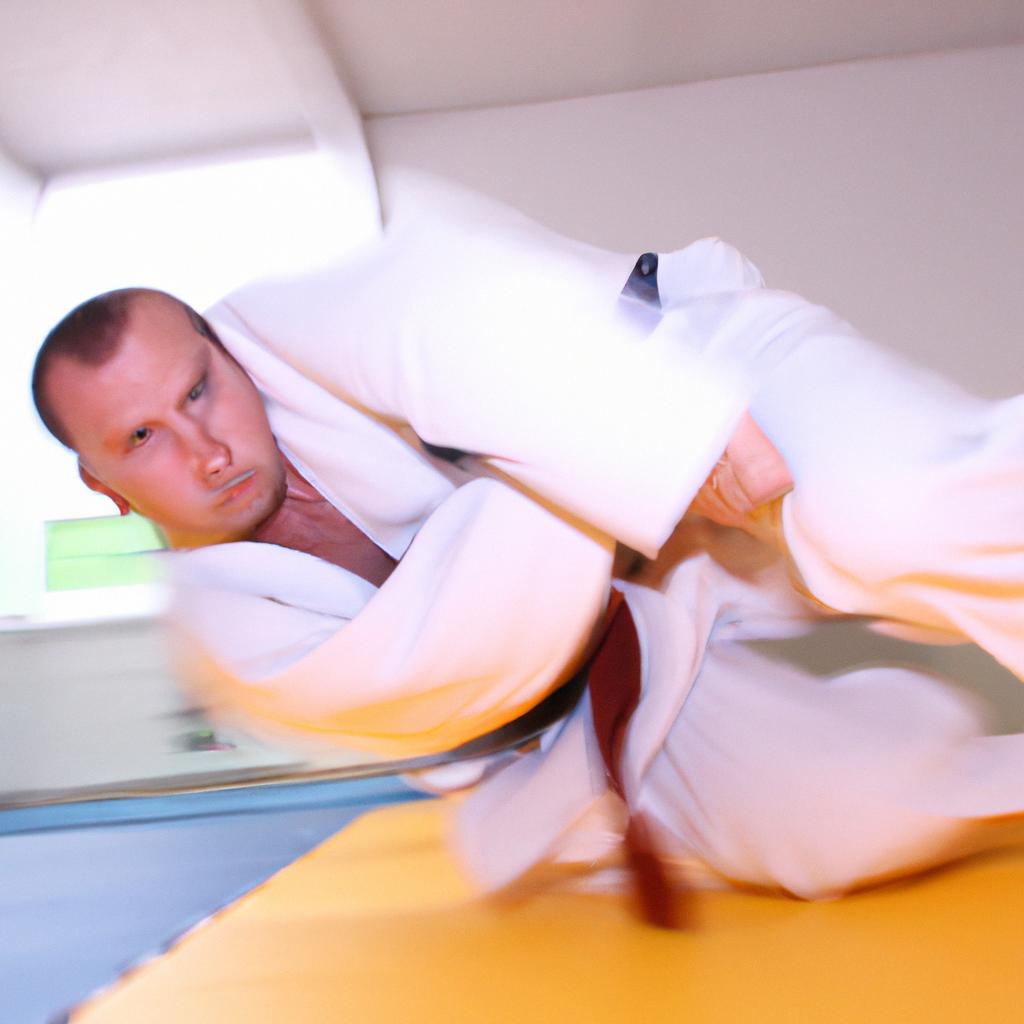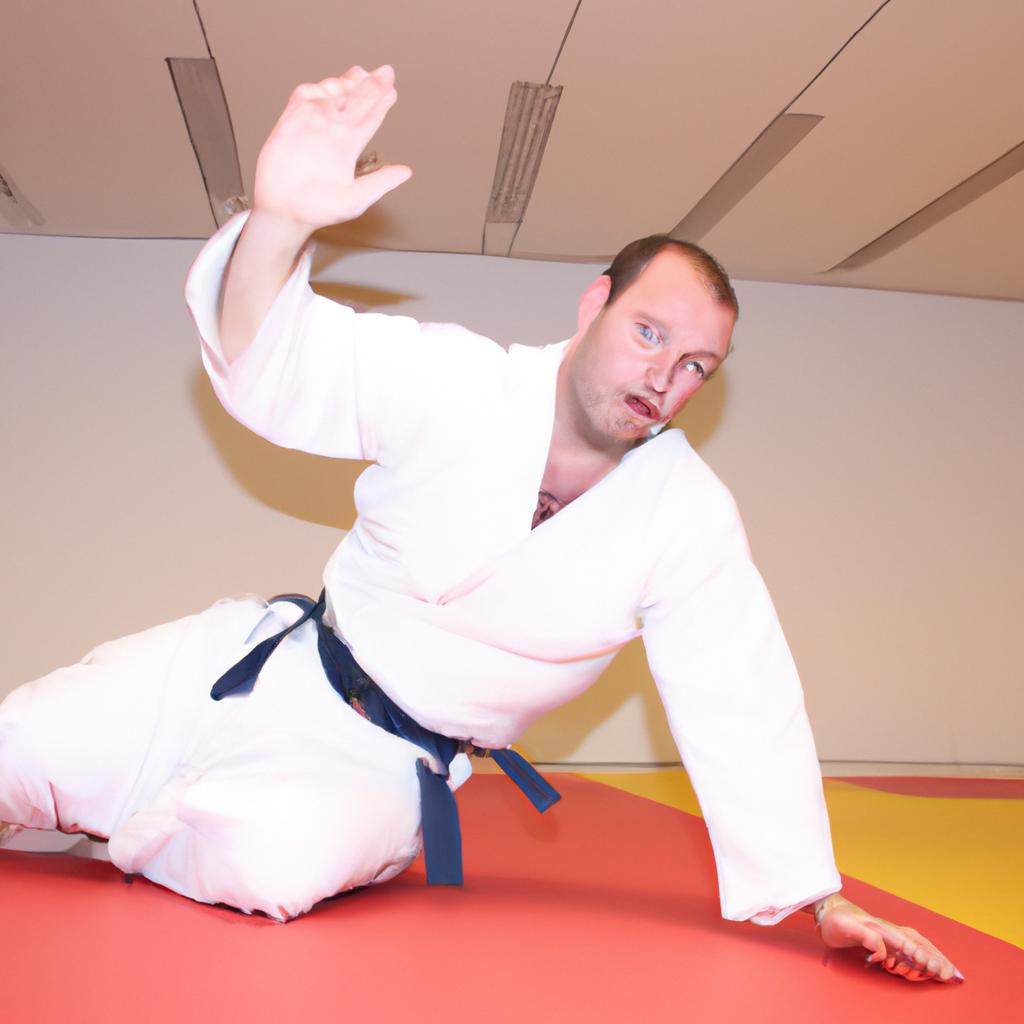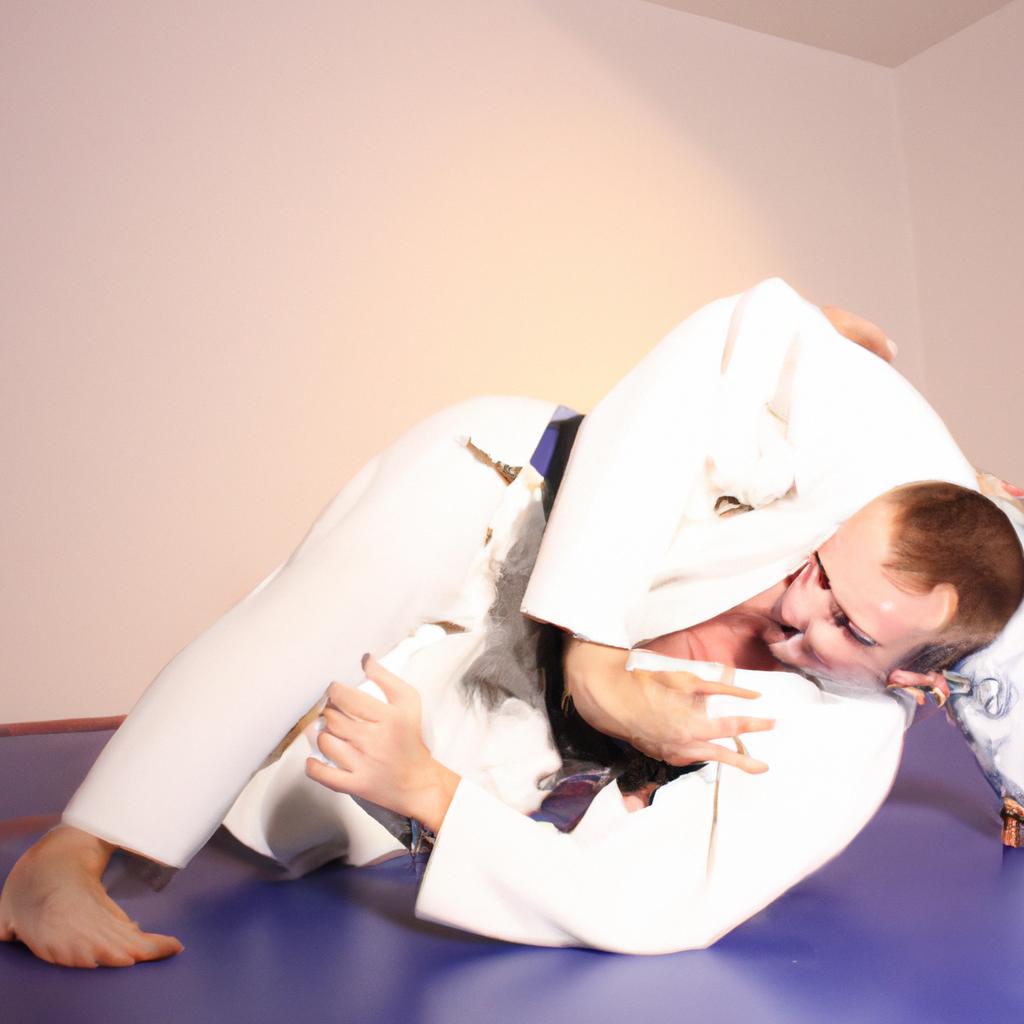Grappling techniques have played a crucial role in various martial arts disciplines, including Mixed Martial Arts (MMA) and Judo. These combat styles emphasize close-range fighting, where opponents engage in intricate holds, throws, locks, and submissions to gain dominance over their adversaries. For instance, consider the case of Alex, an amateur MMA fighter who faced a formidable opponent skilled in grappling techniques during a recent bout. Despite possessing superior striking abilities, Alex found himself at a disadvantage due to his limited knowledge of grappling. This scenario highlights the significance of understanding and mastering grappling techniques within the context of MMA martial arts and Judo.
Exploring these two distinct but interconnected disciplines requires delving into their fundamental principles and training methodologies. In MMA, fighters must possess a well-rounded skill set that encompasses both striking and grappling techniques to be effective inside the cage. The incorporation of judo techniques has become increasingly prevalent in this sport due to its emphasis on throws and takedowns. Conversely, Judo is a traditional Japanese martial art with an intense focus on throwing opponents off balance through precise footwork and leverage manipulation. By examining the similarities and differences between these two practices, one can gain insights into how they complement each other while also appreciating their unique characteristics.
This article This article aims to explore the fundamental principles and training methodologies of grappling techniques in MMA and Judo, highlighting their significance in combat sports and providing insights on how they can be integrated for a well-rounded fighting approach.
History of Grappling Techniques
Imagine a scenario where two fighters, one trained in mixed martial arts (MMA) and the other skilled in judo, face off inside an octagon. Both competitors engage in a fierce battle using various grappling techniques to gain dominance over their opponent. This captivating display of skill and strategy is rooted in a rich history that dates back centuries.
Grappling techniques have been practiced across different cultures throughout history, with each style bringing its own unique approach to combat. In ancient Greece, Pankration was popularized as a form of unarmed combat that combined elements of wrestling and boxing. Similarly, Japanese warriors developed jujutsu, which later evolved into judo and served as the foundation for many modern grappling techniques.
To fully comprehend the significance of grappling techniques today, it is essential to explore their historical context. Here are some key points:
- Ancient Origins: Grappling can be traced back to civilizations such as Ancient Egypt, India, China, and Persia.
- Cultural Influences: Each region’s distinct cultural practices shaped the development of grappling styles.
- Martial Art Evolution: Over time, grappling techniques became refined through rigorous training methods and practical application.
- Global Spread: The dissemination of these techniques occurred through trade routes and international exchanges.
Delving further into the past reveals fascinating stories of legendary grapplers who mastered their craft. For example:
| Name | Style | Notable Feats |
|---|---|---|
| Milo of Croton | Greek Wrestling | Six-time Olympic champion |
| Kano Jigoro | Judo | Founder of modern judo |
| Helio Gracie | Brazilian Jiu-Jitsu | Developed the Gracie Challenge |
Understanding the historical background sets the stage for examining how MMA and judo diverge in terms of technique and philosophy. With this groundwork laid out, we will now explore the key differences between these two grappling styles.
Key Differences Between MMA and Judo
Exploring the Techniques: MMA Martial Arts and Judo
As we delve deeper into the world of grappling techniques, it is essential to understand the key differences between Mixed Martial Arts (MMA) and Judo. To illustrate this further, let us consider a hypothetical scenario where an individual with no prior martial arts experience decides to learn one of these disciplines for self-defense purposes.
Firstly, in MMA, practitioners are exposed to a wide range of fighting styles that incorporate both striking and grappling techniques. This comprehensive approach enables fighters to adapt to various combat situations effectively. Conversely, Judo focuses primarily on throws and groundwork, emphasizing balance, timing, and leverage rather than strikes or kicks.
To better comprehend the distinctions between these two practices, we can examine four key factors:
-
Training Focus:
- MMA encompasses multiple forms of training such as boxing, Muay Thai kickboxing, Brazilian Jiu-Jitsu (BJJ), wrestling, and more.
- In contrast, Judo concentrates on specific throwing techniques called “nage-waza” along with ground control methods known as “ne-waza.”
-
Rules & Regulations:
- MMA competitions permit strikes utilizing fists, elbows, knees, legs while also allowing clinching and takedowns.
- On the other hand, Judo contests restrict striking altogether; instead they emphasize controlled throws aiming for ippon (a full point).
-
Scoring System:
- In MMA bouts points are not awarded per se; victories tend to be determined by knockout or submission.
- Comparatively in Judo matches scores are given based on successful throws or pins lasting 20 seconds or longer.
-
Attire:
- While both disciplines employ a gi during training sessions,
- Some MMA fighters may opt for shorts and rash guards when competing.
- Judokas strictly adhere to wearing their traditional white attire known as judogi.
- While both disciplines employ a gi during training sessions,
Understanding these fundamental disparities between MMA and Judo allows individuals to make informed decisions when choosing a discipline that aligns with their interests and objectives.
Moving forward, we will explore the basic grappling positions commonly found in both MMA and Judo. By gaining a deeper understanding of these fundamental stances, practitioners can build a solid foundation for further skill development.
Basic Grappling Positions
Exploring the Core Principles of Judo in MMA Grappling
To better understand the practical application of grappling techniques in mixed martial arts (MMA), it is essential to delve into the core principles of judo, a discipline renowned for its emphasis on effective groundwork. Let us consider an example where a judoka uses their expertise to secure victory against an opponent with superior striking abilities.
In this hypothetical scenario, the judoka faces off against an experienced striker who excels at maintaining distance and delivering powerful strikes from various angles. As the match begins, the judoka immediately initiates clinching maneuvers, aiming to close the gap between them and neutralize their adversary’s striking prowess. By employing traditional grip fighting techniques derived from judo, such as sleeve grips or collar ties, they are able to establish control over their opponent’s upper body.
Building upon this initial advantage, the judoka transitions seamlessly into executing throws and takedowns that exploit their opponent’s lack of familiarity with ground-based combat. This strategic use of leverage and balance enables them to bring the fight to the mat, further diminishing their adversary’s striking capabilities. Once on the ground, the judoka applies submission holds or pins while leveraging their extensive knowledge of joint locks and chokes to maintain dominance until securing a decisive victory.
Examining this case study helps illustrate how certain key elements found within both MMA grappling and traditional forms like judo can be effectively utilized in real-world scenarios. To gain further insight into these principles, let us explore four fundamental tenets underlying successful grappling techniques:
- Control: Maintaining command over one’s opponent through proper positioning and technique.
- Timing: The ability to exploit momentary weaknesses by capitalizing on precise openings.
- Adaptability: Adjusting strategies based on evolving circumstances during a bout.
- Transition Fluidity: Seamlessly moving between different positions and submissions in response to changing situations.
Understanding these foundational aspects is crucial when discussing the implementation of grappling techniques in MMA. By recognizing the importance of control, timing, adaptability, and transition fluidity, fighters can optimize their performance within this discipline.
| Control | Timing | Adaptability | Transition Fluidity |
|---|---|---|---|
| Ensures dominance over opponent’s movements | Exploits vulnerabilities in real-time | Adjusts strategies based on changing circumstances | Facilitates smooth transitions between positions and submissions |
With a solid grasp of these principles, we can now explore the striking versus grappling dynamic within MMA. Understanding how these two aspects complement each other is crucial to succeeding in mixed martial arts competition.
Striking vs. Grappling in MMA
Exploring Different Grappling Techniques in MMA
Imagine a scenario where two fighters with distinct backgrounds in martial arts, one trained in Brazilian Jiu-Jitsu and the other in Judo, step into the octagon for an intense mixed martial arts (MMA) match. As they engage in combat, their grappling techniques become pivotal to gaining control and potentially finishing the fight. In this section, we will delve further into the world of MMA and Judo by exploring various grappling positions and understanding the significance of striking versus grappling.
To comprehend the intricacies of grappling within MMA, it is essential to familiarize ourselves with several fundamental positions that form its foundation. These positions serve as starting points from which fighters can either gain dominant control or attempt submissions. Some common examples include:
- Mount Position: This position grants the fighter on top complete control over their opponent by straddling them while maintaining superior leverage.
- Guard Position: When a fighter finds themselves on their back with their legs wrapped around their opponent’s waist or torso, they are said to be in “guard.” From here, they can create offensive opportunities using sweeps or submission attempts.
- Side Control Position: With one athlete pinning their opponent’s body against the mat while being perpendicular to them, side control offers significant control and sets up chances for ground-and-pound strikes or submissions.
- Back Mount Position: Considered one of the most advantageous positions, securing back mount allows a fighter to have full control over their adversary’s back while having both hooks securely attached.
Understanding these key positions provides valuable insights into how competitors manipulate each other during matches. While striking abilities play a crucial role in MMA fights, there is often a strategic shift towards grappling when fighters recognize openings or seek to neutralize opponents who possess exceptional stand-up skills.
Embracing grappling techniques has proven effective across numerous high-profile encounters throughout MMA history. For instance, renowned fighters like Georges St-Pierre and Khabib Nurmagomedov have showcased their grappling prowess, utilizing it to dominate opponents who excelled in striking. By employing well-executed takedowns, maintaining control through various positions, and capitalizing on submission opportunities, these fighters exemplify the importance of a comprehensive approach that includes both striking and grappling.
As we move forward into the next section discussing effective submissions in grappling, let us continue our exploration of MMA martial arts by examining how skilled practitioners employ techniques such as chokes, joint locks, and other strategic maneuvers to secure victory inside the cage.
Effective Submissions in Grappling
Exploring the Role of Effective Submissions in Grappling
Consider a hypothetical scenario: two skilled grapplers facing off in an intense MMA match. As they engage, one fighter swiftly maneuvers into position and executes a flawless armbar submission, forcing his opponent to tap out within seconds. This example highlights the vital role that effective submissions play in grappling arts such as Judo and mixed martial arts (MMA). In this section, we will delve deeper into the concept of submissions and their significance within the realm of grappling.
Submissions are techniques used to force an opponent into surrender by applying pressure or causing extreme discomfort through joint locks, chokes, or other means. They require not only technical proficiency but also strategic thinking and anticipation of your opponent’s moves. To truly excel at submissions, it is crucial to understand various factors that contribute to their effectiveness:
- Timing: Executing a submission at precisely the right moment can catch opponents off guard and leave them with little time to react.
- Technique: Proper execution is paramount when attempting any submission hold; even slight errors can result in loss of control or escape for your adversary.
- Positioning: Maintaining advantageous positions on the ground allows you to apply leverage effectively and limit your opponent’s options for escape.
- Transitioning: Seamlessly transitioning between different submission attempts keeps your adversary guessing and increases your chances of success.
To further illustrate these points, let us consider a comparison table showcasing some common submissions utilized in both Judo and MMA:
| Submission | Description | Key Principles |
|---|---|---|
| Armbar | Hyperextending the elbow joint using legs | Timing, technique |
| Rear Naked Choke | Applying pressure on carotid arteries from behind | Positioning |
| Triangle Choke | Trapping head and arm while compressing neck | Technique, transitioning |
| Kimura Lock | Applying shoulder pressure by leveraging the opponent’s arm | Technique, positioning, transitioning |
Examining these submissions allows us to appreciate the diversity of techniques employed in grappling. Each submission requires a unique combination of factors for optimal execution and effectiveness.
In summary, mastering effective submissions is an essential aspect of grappling arts such as Judo and MMA. By understanding the importance of timing, technique, positioning, and transitioning, practitioners can enhance their chances of securing victory through submission holds.
Training Tips for Improving Grappling Skills
Exploring Different Training Methods for Grappling
In the previous section, we delved into effective submissions in grappling. Now, let us turn our attention to training tips that can help improve your grappling skills. To illustrate the effectiveness of these methods, consider a hypothetical scenario where an amateur grappler named Alex is struggling to execute takedowns during matches.
One crucial aspect of improving grappling skills is developing strength and conditioning. By incorporating targeted exercises into their training routine, such as deadlifts and squats, grapplers can enhance their overall physical power and explosiveness. Additionally, including cardiovascular workouts like running or cycling helps build endurance necessary for longer bouts.
Another valuable technique is drilling specific sequences repeatedly until they become second nature. This repetitive practice aids muscle memory development, allowing grapplers to react instinctively during live matches. For instance, Alex could focus on practicing his double-leg takedown by partnering with teammates who are well-versed in defending against it.
Furthermore, supplementing regular training sessions with cross-training activities can offer diverse skill sets that can be applied to grappling situations. Engaging in disciplines such as Brazilian Jiu-Jitsu (BJJ), wrestling, or even judo contributes to a well-rounded approach towards grappling techniques. By gaining exposure to different styles and strategies through cross-training, grapplers like Alex increase their adaptability and broaden their arsenal.
To summarize the key points above:
- Incorporate strength and conditioning exercises like deadlifts and squats.
- Perform cardiovascular workouts for improved endurance.
- Drill specific sequences repetitively to develop muscle memory.
- Cross-train in disciplines like BJJ or judo for a varied skill set.
By adopting these training tips consistently, aspiring grapplers like Alex have the opportunity to refine their techniques further and reach new levels of proficiency. Remember that dedication and persistence are vital components of any successful training regimen—practicing regularly will undoubtedly yield positive results over time.




